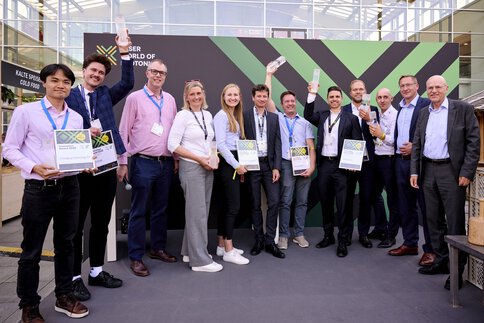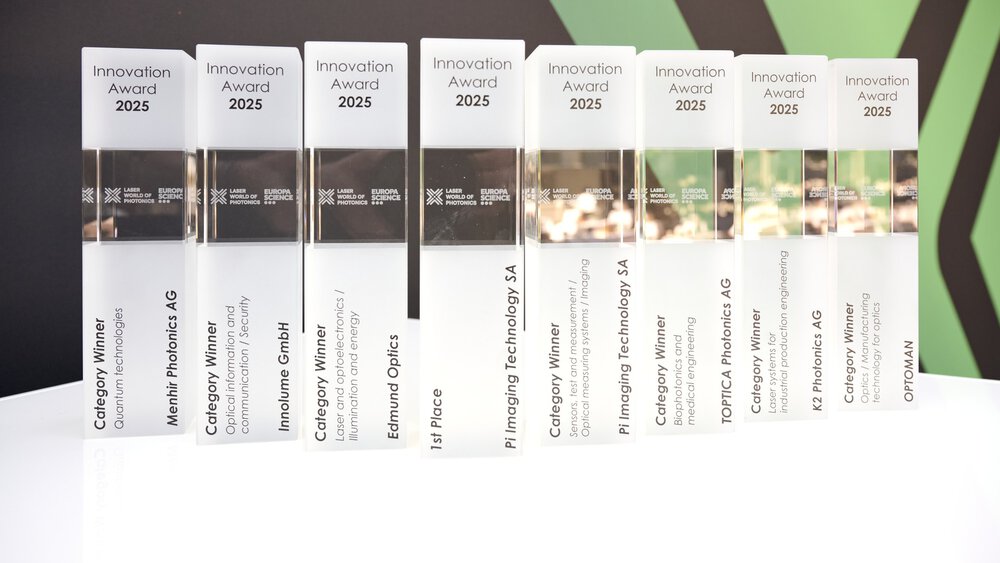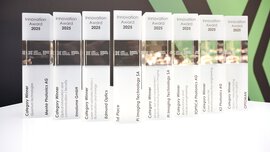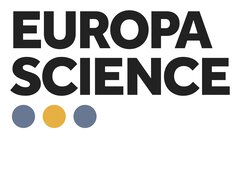Der Innovation Award geht in die vierte Runde
Der Innovation Award wurde am 24. Juni 2025 in Kooperation mit dem britischen Fachverlag Europa Science verliehen! Hier finden Sie die Gewinner und Impressionen.
Die Award Gewinner 2025
Pi Imaging Technology SA gewinnt den mit 5.000 Euro dotierten Innovationspreis für seinen SPAD Alpha. Herzlichen Glückwunsch!
Die Kategorie-Gewinner:
- Edmund Optics - PeakPower High LDT Low GDD Ultrafast Mirrors (Laser and optoelectronics / Illumination and energy)
- TOPTICA Photonics AG - FemtoFiber ultra FD 780/920/1050 nm (Biophotonics and medical engineering)
- Menhir Photonics AG - MENHIR-1030 at 1 GHz (Quantum technologies)
- OPTOMAN - Non-Degrading UV Optics (Optics / Manufacturing technology for optics)
- Pi Imaging Technology SA - SPAD Alpha (Sensors, test and measurement / Optical measuring systems / Imaging)
- K2 Photonics AG - K2-ASOPS (Laser systems for industrial production engineering)
- Innolume GmbH - High saturation power O-band semiconductor optical amplifier (Optical information and communication / Security)

Fotogalerie des Innovation Awards 2025












Die Kategorien
Es standen folgende Kategorien zur Auswahl:
- Lasersysteme für die industrielle Fertigung / Laser systems for industrial production engineering
- Laser und Optoelektronik / Beleuchtung und Energie / Laser and optoelectronics / Illumination and energy
- Biophotonik und Medizintechnik / Biophotonics and medical engineering
- Optik / Fertigungstechniken für Optik / Optics / Manufacturing technology for optics
- Sensorik, Mess- und Prüftechnik / Optische Mess-Systeme / Sensors, test and measurement / Optical Measuring Systems / Imaging
- Optische Information und Kommunikation / Sicherheit / Optical information and communication / Security
- Quantentechnologien / Quantum Technologies

Laser World of Photonics Innovation Award 2025 – Shortlist
Die Jury des Innovation Awards hat eine Shortlist aus den besten Innovationen ausgewählt. Aus diesen wurden die Kategoriegewinner und der Gesamtgewinner ermittelt.
Der Innovation Award ist mit einem Preisgeld von 5.000 Euro dotiert. Dieser Preis wird von Europa Science mit den Fachpublikationen Electro Optics, Laser Systems/Europe, Fibre Systems sowie Imaging and Machine Vision Europe sowie der Laser World of Photonics gesponsert.
Hier eine Übersicht nach Kategorien:
Laser and optoelectronics / Illumination and energy
PeakPower High LDT Low GDD Ultrafast Mirrors’ ability to maintain > 99.5% reflectivity and a near-0 GDD while achieving the highest available laser damage threshold (LDT) is unique in the market, exceeding 0.75J/cm2 for 25fs pulse durations at 920nm. Clever combinations of coating layer materials and optimized coating processes allow for these demanding specifications to be achieved simultaneously, where normally LDT must be sacrificed for high reflectivity and GDD, or vice versa.
The TruMicro 9010 is the most powerful industrial ultra-short pulse laser in its class, delivering 10 GW peak power at a 100 kHz repetition rate and an outstanding 1 kW average power. By combining a slab laser module with a multi-pass cell, the TruMicro 9010 offers exceptional flexibility with repetition rates from 100 kHz (10 mJ) to 50 MHz (20 µJ), including burst modes. Its unmatched power and precision enable efficient scaling of existing applications and pave the way for new industrial use cases.
Biophotonics and medical engineering
Futonics’ 2 µm thulium fibre laser delivers 1000 W QCW / 200 W CW and incorporates a patented coupling system, engineered in Germany for advanced performance and long-term stability. The system enables precise and minimally invasive lithotripsy, contributing to progress in laser-based medical procedures.
Unlock new possibilities with our pocket-sized 1030 nm femtosecond laser oscillator, delivering >1 W average power and <200 fs pulses at 50 MHz. Its ultra-compact footprint of 70×49×28 mm³ -including cooling and electronics- enables seamless integration into portable and space-limited setups. Enjoy cutting-edge performance for biomedical applications such as optogenetics or 2-photon imaging, advanced research, and as robust seed source for amplifiers - all in a footprint that fits anywhere!
Completely replacing the free-space paths between a watt-level femtosecond laser and a two-photon microscope is a game-changer for modern microscopy. By delivering femtosecond pulses directly from the laser source to the microscope via an optical fiber, users can enable entirely new microscope designs while significantly improving laser safety and usability. With the FemtoFiber ultra FD there is no need for mirror alignment or power meters. Setup is fast and easy.
Quantum technologies
The attoCMC enables easy access to cryogenic temperatures required for photonic quantum technologies. Its compact, automated design eliminates complex lab infrastructure, cuts operational costs, and lowers energy consumption. Running on low power with no need for external cooling, it is ideal for real applications in datacenters. The plug-and-play system accelerates innovation, helping users quickly implement quantum solutions in real-world environments.
The MENHIR-1030 is the first industrial-grade 1 GHz femtosecond laser, offering ultra-low noise, extreme stability, and 24/7 maintenance-free operation. Its compact, user-friendly design makes it perfect for high-precision tasks, from generating high-flux single and entangled photons in quantum technologies to achieving ultra-high peak power with coherent combining and enabling GHz burst mode in material processing. This ensures precise, reliable performance with minimal user effort.
Explore wide mode-hop-free tuning from 750 to 790 nm! Perfect for pumping and probing (micro) cavities and Rb or K atoms, or for characterizing photonic devices across a broad wavelength range.
CTL lasers are the perfect choice when your application demands large mode-hop-free tuning ranges – from resonant excitation of tiny structures like quantum dots and micro-cavities, to molecular spectroscopy and advanced component testing.
Optics / Manufacturing technology for optics
Midel Photonics pioneers All-Reflective Beam Shaping, using innovative microstructured mirrors for precise beam shaping, splitting, and focusing. Laser applications often suffer from unsuitable energy distribution, limiting quality and increasing costs. Midel Photonics' reflective optics solve these issues by providing optimal energy distribution, significantly reducing energy losses, enhancing performance, and giving customers a competitive edge in macro- and micro-machining and life sciences.
OPTOMAN’s Non-Degrading UV Optics set a new industry standard by eliminating performance degradation and enabling high-power UV laser applications. These mirrors are optimised for ultrashort (fs/ps) pulse regimes at UV wavelengths (257 nm and 343 nm), which are crucial for demanding industrial laser processing applications. Unlike conventional UV optics that begin to degrade after 1,000 hours of high-power laser exposure, they maintain peak performance beyond 10,000 hours.
Sensors, test and measurement / Optical measuring systems / Imaging
A new optical wafer tester compatible expands existing standard semiconductor automated test equipment (ATE) with fab-capable optical test hardware. It integrates tightly with ATE to support double-sided electro-optical (e-o) test of a wafer – DC and high-data-rate test capability above, and six-axis actively aligned optical probing below. The new tester is targeted at volume e-o test of wafer-level silicon photonics (PICs) destined for AI-driven co-packaged optics (CPO) chiplet applications.
Hamamatsu Photonics introduces its cost-effective fingertip-sized UV spectrometer C16767MA, which is highly sensitive in the UV range using proprietary MEMS technology. C16767MA splits UV light in the range of 190 to 440 nm into individual wavelengths and then measures the light intensity at each wavelength with high resolution. Thanks to its innovative, compact design, the UV mini spectrometer can be easily integrated into environmental measuring devices.
SPAD Alpha is a megapixel single-photon camera, available in color or monochrome. It offers zero readout noise, dark count rate below 100 cps, and global shutter for nanosecond exposures. It supports full-resolution photon counting up to 73,000 fps, and tunable resolution to reach over a million fps. With 6-ns gating and 17-ps shift resolution, it enables time-resolved imaging. SPAD Alpha delivers high SNR, over 100 dB dynamic range, and outperforms standard cameras in low-light and 3D imaging.
Laser systems for industrial production engineering
FemtoLux is a 50 W femtosecond laser with unmatched reliability thanks to its innovative Direct Refrigerant Cooling (DRC) system—proven in military use with 90,000 h MTBF. DRC eliminates the need for servicing, reduces the laser footprint, and is the most efficient cooling method available. Compact and maintenance-free, it offers 24/7/365 operation, <0.5% power stability and advanced options like harmonics (515 nm, 343 nm), pulse-on-demand and GHz burst for demanding micromachining tasks.
K2-ASOPS is a compact 60 MHz femtosecond laser producing two output beams, from nearly the same components as a single laser, with one key difference: each beam runs at nearly identical repetition rates, but with a controllable and stable difference. This light source represents a new class of ultrafast lasers with the potential to revolutionize laser measurement applications, such as semiconductor wafer inspection, layer thickness analysis, adhesion inspection, and other advanced material characterization.
Zwobbel-IR-HP by ROBUST AO enables real-time axial beam shaping in high-power lasers (up to 20 kW), using a deformable mirror oscillating at up to 3500 Hz. It adjusts Rayleigh length, spot size, and intensity profile for dynamic control of energy density. Compact (<500 g) and easy to integrate, it enhances 3D laser processing, boosting speed (+90%), quality, and efficiency in cutting, welding, and structuring.
Optical information and communication / Security
The O-Band Quantum Dot Semiconductor Optical Amplifier (QD SOA) delivers EDFA-like performance for the first time in a compact, electrically pumped semiconductor device. It provides either simultaneous amplification of multiple modulated laser lines with minimal BER degradation or very high output power at a single wavelength. This uncooled, energy-efficient SOA enables advanced platforms for datacom, AI connectivity, terrestrial Free Space Optical (FSO) links, FMCW LiDAR, and optical switching.
The new PSH 20/2 and PSH 35/2 are piezo-driven, high-performance two-axis tilting stages delivering up to ±22 mrad tilt, 1.0 µrad resolution (closed loop), and up to 2 kHz resonance. Originally developed as Fast Steering Mirrors (FSMs) for space, they offer unmatched speed, precision, and low power use in extreme conditions. PSH 35/2 adds stroke and thermal stability; PSH 20/2 excels in efficiency and high-frequency operation—redefining beam control in laser, photonics, and aerospace systems.
Zerothird GmbH’s eQKD systems use polarization-entangled photon pairs and superconducting nanowire detectors for secure quantum key distribution (BBM92 protocol). The industrial design includes a photonic layer that eliminates optical realignment, improving reliability and stability in real-world environments. The systems support short- and long-distance links (up to 350 km) and star-topology networks, offering enhanced security for critical communication infrastructure.
Die Jury des Innovation Awards 2025
| Name | Unternehmen |
|---|---|
Tom Hausken | Optica – formerly OSA |
Agnes Huebscher | Edmund Optics GmbH |
Dr. Chris Yates | Vision Ventures, Germany |
Dr. Wilhelm Kaenders | TOPTICA Photonics AG |
Prof. Peter Loosen | Fraunhofer-Institut für Lasertechnik ILT |
Prof. Jürgen Popp | Leibniz-Institut für Photonische Technologien Jena |
Dr. Peter Soldan | VDI Technologiezentrum GmbH |
Prof. Ronald Sroka | LIFE-Center, Hospital of University Munich |
Dr. Wenko Süptitz | SPECTARIS |
Prof. Andreas Tünnermann | Fraunhofer-Institut für Angewandte Optik und Feinmechanik IOF |
Prof. Paul Urbach | TU Delft |
3 Schritte zu Ihrer Teilnahme am Innovation Award
1. Innovation(en) einreichen: Januar 2025 – 21. März 2025
Reichen Sie Ihre Innovation(en) bis zum 21. März über den Ausstellershop in englischer Sprache ein. Die Einreichungen müssen die folgenden Kriterien erfüllen:
- Das Produkt wurde erstmals nach der Laser World of Photonics 2023 (Juni 2023) auf den Markt gebracht.
- Es handelt sich um ein marktreifes System, das von Endkunden oder Systemintegratoren erworben werden kann, und nicht um einen Prototyp. Die Präsentation/ Markteinführung brandneuer Produkte muss spätestens auf der Laser World of Photonics 2025 / World of Quantum 2025 erfolgen.
- Wenn möglich, geben Sie bitte eine Preisspanne, die Zielgruppe und eventuell bereits einen ersten Kunden/Interessenten an.
2. Auswahlprozess: ab 24. März 2025
Ab dem 24. März 2025 begutachtet die Jury die Einreichungen und wählt pro Kategorie die drei besten Innovationen aus. Anschließend werden in einem Voting-Prozess aus den TOP 3 Platzierungen die jeweiligen Kategorie-Gewinner und aus den Kategorie-Gewinnern der Innovation Award Gewinner ermittelt.
3. Innovation Award Verleihung: 24. Juni 2025
Die Preisverleihung findet am 24. Juni 2025 im Rahmen des Ausstellerabends der Laser World of Photonics 2025 statt.


